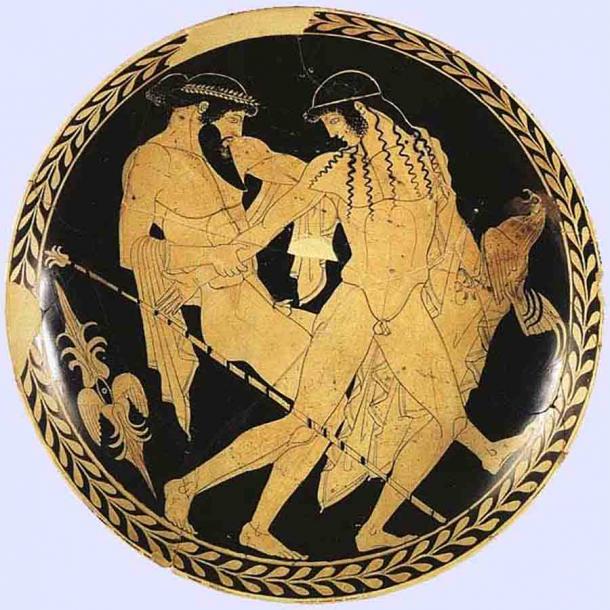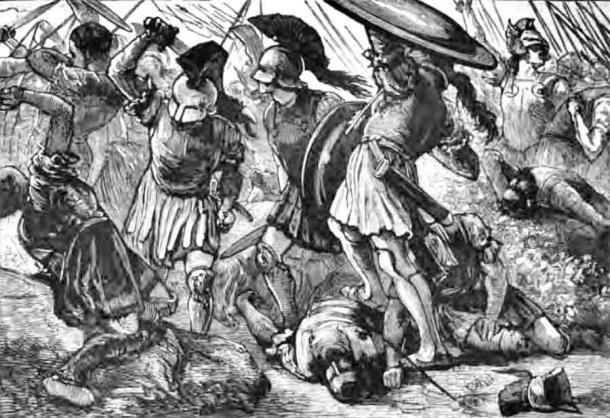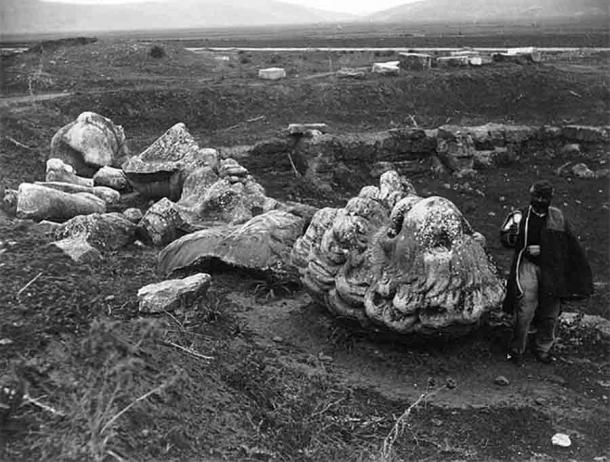The Sacred Band of Thebes was an elite fighting unit consisting of 300 Theban soldiers who were not only warriors but coupled lovers as well. According to the scholar Plutarch, the creation of the unit took place sometime between 379 and 378 BC, the brainchild of Gorgidas, a military leader who believed that those who were lovers would fight more ferociously to keep each other alive than those who were not. It was General Pelopidas that then structured this elite unit of coupled lover soldiers into a formidable fighting force which went on to gain the respect of all of late-classical Greece. Their existence spanned forty years, from 378 to 338 BC, and their legacy lives on even today.
Long-Lasting Legacy of the Sacred Band of Thebes
The most famous battle fought by the Sacred Band of Thebes took place in 371 BC against the Spartans in the %20
This single act resulted in the undying respect of both Philip II and his young son %20

The mass grave of the Sacred Band of Thebes was reconstructed in this illustration by Markley Boyer. (Markley Boyer / CC BY-SA 4.0 )
Their act of valor echoed through the ages, so much so that in 300 BC the Greek city of Thebes built a stone lion on a pedestal in their honor to mark the mass burial site. This site still exists in the present day in the village of Chaeronea, Greece. But how is it that such a unit could exist in ancient times? On closer examination, the Sacred Band of Thebes reveals much more about ancient Greek warfare and culture.
Homosexuality in the Theban Culture of Ancient Greece
These days the concept of an elite fighting force consisting of gay couples is a controversial topic to discuss openly in a military context. Since 1993, the United States Armed Forces maintain a “don’t ask and don’t tell” policy regarding sexual identity and romantic relationships between their enlisted. In %20
This fact emphasized the popular sexual preference for pedagogical pederasty (love between an older man and a younger boy) embedded within ancient Greek scholarly culture. It was so inherent that in Plato’s %20

Homosexuality was represented in ancient Greek pottery. This example depicts the story of Zeus and Ganymede. ( Public domain )
The ancient Greeks did not culturally perceive this in the same way. Homosexuality in Greece greatly differed in how %20
This cultural acceptance of gay relationships was reflected in Plato’s Symposium, to which he stated in a dialogue regarding %20
Like the Sacred band of Thebes, the %20
Creating the Concept of the Sacred Band of Thebes
The history of Thebes spanned as far back as Mycenaean times and emerged in the ancient region of Boeotia, becoming the leading power within the Boeotian Confederacy. The Sacred Band of Thebes is somewhat responsible for securing Thebes’ power and reputation in the region. Since its early beginnings, Thebes had also infamously maintained hostility against Athens and most famously sided with the Persian Invasion (480 to 479 BC) shortly after Thermopylae. Thebes remained a continuously adversarial city-state towards not only the Athenians but the Spartans as well.
As mentioned before, Thebes was much respected in the art of war. In furthering their %20
Gorgidas not only felt that Thebes needed an elite fighting force, but that it needed to encompass %20

The military experiment of creating an army of homosexual lovers resulted in the infamous Sacred Band of Thebes ( sissoupitch / Adobe Stock)
The Military History of the Army of Lovers
The Sacred Band of Thebes was imagined first by Gorgidas and then refined into a formidable army by the generals Pelopidas and Epaminondas. One of the most famous battles that brought significant recognition to the sacred band of Thebes took place in 371 BC during the Battle of Leuctra. This conflict saw the Thebans facing off against the %20
The traditional design of a Greek military column saw the best and most elite warriors were placed on the right wing. At the same time, the left wing was composed of officers, influential individuals, and weaker soldiers. The Sacred Band of Thebes, led by General Pelopidas, made up the right wing of the Theban columns. When the opportunity presented itself, the Theban cavalry wreaked havoc upon the Spartan lines, the sacred band seized control. It strategically attacked the Spartan right, resulting in the loss of one thousand Spartan men, including King Clembrotus I.
Although the novel strategies performed by the Thebans were crucial to their success over the Spartans, it was also their enduring training and discipline that was credited for their success. The selection process required individuals possess athletic ability and previous military experience. Not only were they supposed to be great specimens of the male physique, but they had to have lovers of equal physical beauty and prowess.
Similar to many early professional soldiers, members of the Sacred Band of Thebes was required to training and exercise continually in preparation for any possible conflicts that could arise. The men trained in wrestling, swordsmanship, boxing, and early formations of the Phalanx. Like the Athens military, those who served in the Sacred Band of Thebes were also expected to participate in the arts, recite poetry, and understand philosophy.
This gymnasium-like training was believed to create a smarter and more intellectual form of a soldier that could prove significantly more adaptable to the unforgiving nature of Greek warfare. It was rumored that their training was designed to match the intellect of the Athenians and the brutality of the Spartans. The lessons learned by their strategic successes, training and sexual preference were studied by Philip II of Macedon, and he incorporated certain traits into the perfection of his own fighting force. It would also inevitably lead to Philip II’s victory over the Sacred band of Thebes in the Battle of Chaeronea in 338 BC.

The Sacred Band of Thebes met its tragic end at the Battle of Chaeronea. ( Public domain )
Tragic Demise at the Battle of Chaeronea
For Philip II, the %20
Philip II could either win and have all of Greece or lose his dominance, his life, and his very own son and be another defeated warlord who perished when faced with the might of the Sacred Band of Thebes. Within the heat of the battle, Phillip II used a strategy similar to one used by the Thebans themselves against the Spartans, whereby he faked a retreat only to strengthen his own column and place the Athenian line opposite him.
<iframe width=”560″ height=”315″ src=”%20
Alexander led the charge and overwhelmed the Sacred Band, yet, even though their Athenian allies began to surrender, the Thebans fought on and refused to back down to either Alexander or his father Philip II. No matter how many arrows, charges, or spears engaged them, the Sacred Band endured until they were no more.
And as mentioned before, historic accounts by Plutarch, Polyaenus, and many others stated that Philip II observed a moment of silence and then wept in remembrance of the bravery demonstrated by his fallen adversaries. This defeat inspired great respect in Philip II, as well as evoking an immense impression on his son %20

Fragments of a lion statue were discovered in 1818 by George Ledwell Taylor. This led to the discovery of a mass grave of members of the Sacred Band of Thebes killed in battle in 338 BC. ( Public domain )
Archaeological Evidence of the Sacred Band of Thebes
With so many accounts of their great fighting prowess and their unique cultural traits, historians have wondered whether they were characters originating in fiction or if they actually existed in the real world. It wouldn’t be until the 19 th century that physical evidence of their existence would be found. In Daniel Mendelsohn’s 2021 article, he discussed an 1818 archaeological discovery by George Ledwell Taylor.
In Taylor’s casual exploration of the ancient ruins of Chaeronea, he found himself in the proximity of a stone sculpture mimicking a colossal head of a lion and standing six feet high. Taylor grew excited, for he had an inkling that this statue could be the famed Lion of Chaeronea, a statue that had been mentioned within several documents of antiquities. As stated by Mendelsohn, one such source was from the second century AD geographer Pausanias, who claimed that a giant stone figure was created in respect of a great fighting force that he called “The Spirit of Men.”
The Mendelsohn article continues to discuss the further excavations that occurred in 1890, sixty years after Taylor’s discovery. The Lion of Chaeronea was not only a memorial marker for the Battle of Chaeronea which took place in 338 BC, but also a tombstone marking a mass grave. The excavations revealed over 254 skeletal remains placed in a rectangular column. The remains were arranged in seven rows.
In Mendelsohn’s writing, he mentions the illustration by Markley Boyer (above), based on 19 th century drawings of excavations, which reconstructed the position of each skeleton within the column of the %20
In the years after the Battle of Chaeronea, Philip II of Macedon would reign supreme in Greece, after which %20
Top image: The Sacred Band of Thebes became legendary for its military prowess. Source: warpaintcobra / Adobe Stock
By B. B. Wagner
Related posts:
Views: 1
 RSS Feed
RSS Feed

















 June 3rd, 2021
June 3rd, 2021  Awake Goy
Awake Goy  Posted in
Posted in  Tags:
Tags: 
















